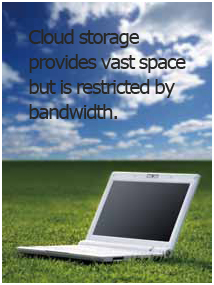Setting the same storage over a network connection changes many considerations. The accessibility and safety of stored data is complicated by additional users accessing the same information, as well as the management of both data and retrieval/access traffic.
Extended Storage in NAS /SAN and the Cloud
Setting the same storage over a network connection changes many considerations. The accessibility and safety of stored data is complicated by additional users accessing the same information, as well as the management of both data and retrieval/access traffic.
From a security perspective, the information stored is not just simple documents, but large amounts of footages that need to be managed for possible evidentiary use later. For recording clips of interest or other small files from video surveillance systems, NAS is sufficient as an extended storage solution, said Jeff Whitney, VP of Marketing, Intransa. “The NAS file system adds another layer of operating system complexity to any solution, however, and is designed to support IT applications like word processing and e-mail files, and not streaming video.” To operate NAS/SAN solutions, the Windows environment is easier for integration, with more options embedded in the operating system, Maughan said.
Cloud Storage
 Cloud storage is relatively new in physical security industry, and so far has remained the domain of IT professionals. “In the long run the benefits of the cloud will surpass today's bandwidth limitations,” said Roela Regalado, Marketing Manager, DNF Security. “The cloud's benefits of transparent availability, capacity and policy-based use of resources will be the deciding factor. However, the lower cost of entry and ease of management today fall to NVR applications and storage products with advanced features.
Cloud storage is relatively new in physical security industry, and so far has remained the domain of IT professionals. “In the long run the benefits of the cloud will surpass today's bandwidth limitations,” said Roela Regalado, Marketing Manager, DNF Security. “The cloud's benefits of transparent availability, capacity and policy-based use of resources will be the deciding factor. However, the lower cost of entry and ease of management today fall to NVR applications and storage products with advanced features.
For now industry experts are reserved about using cloud storage for security needs. “Protection of data and restriction of unauthorized access to video footage is important, and in the private and public space effort is placed into making sure information does not fall into the wrong hands,” Harraway cautioned. “If the same scenario is taken to a cloud, where access is quickened and made efficient through IP access, it would take extra careful efforts to ensure the same level of performance.”
 One of the foremost concerns of industry experts is bandwidth. “Cloud storage is not restricted in terms of space, for the actual storage facilities are distributed across all continents, but bandwidth is a limiting factor, especially with megapixel cameras and 30 fps recording,” Kreutz said. “Also, bandwidth capability influences the speed and size when transferring data to and from the extended storage.”
One of the foremost concerns of industry experts is bandwidth. “Cloud storage is not restricted in terms of space, for the actual storage facilities are distributed across all continents, but bandwidth is a limiting factor, especially with megapixel cameras and 30 fps recording,” Kreutz said. “Also, bandwidth capability influences the speed and size when transferring data to and from the extended storage.”
In the vast space provided by cloud, redundancy is available with RAID and backup options, which are IT-standardized, Kreutz said. Data could be streamed into two entirely separate locations to prevent data loss. “When dealing with redundancy, one has to be cognizant of the performance requirements required to replicate data across a number of appliances,” Maughan said.
Cloud storage deployments must consider data accessibility and security. Video footage often serves as a witness when investigating suspected events, and tampering with evidentiary recording might prove disastrous for court purposes. “Data security issues and concerns need to be heeded before enterprises are comfortable with this route,” Yin said. “For now, large-scale corporations are reluctant to adopt the public cloud as it requires extra effort and labor to manage information and access. It's the same with private cloud — applications still need time to mature, and initial investment may be higher than originally budgeted for.”
 Secure access control is one consideration shared by many. “To ensure data security and privacy, some RAID solutions support government- approved AES encryption algorithm,” Chou said. “In addition, self-encrypting drives prevent data leakage through unauthorized access,and deliver comprehensive data security and privacy compliance.”
Secure access control is one consideration shared by many. “To ensure data security and privacy, some RAID solutions support government- approved AES encryption algorithm,” Chou said. “In addition, self-encrypting drives prevent data leakage through unauthorized access,and deliver comprehensive data security and privacy compliance.”
In the U.S., government regulations spell out storage requirements. “For government use, standards are adopted for all network connected systems controlled by the DoD Information Assurance Certification and Accreditation Process,” Kreutz said. The degree of public acceptance and incursion of cloud storage for security purposes will become more evident as time goes on, but for now this option seems to be in its early stages.
Another area to pay attention to is the service label agreement (SLA) and service charges that come with using storage in the cloud. SLAs might contain regulations or information that would not work to the benefit of the users should conflicts arise, so it is safer for consumers to read and understand the SLAs stipulated by the service providers before deciding on this option. While users could save on hardware by storing video to the cloud, whether service charges will prove to be affordable in the long run needs to be thoroughly explored by users prior to joining the service.